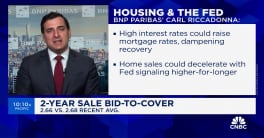What is an FHA Scorecard?
HUD describes the FHA Scorecard as such...
"The FHA TOTAL Scorecard was developed by HUD to evaluate the credit risk of FHA loans that are submitted to an automated underwriting system. To underwrite an FHA loan electronically, a mortgagee must process the request through an automated underwriting system that can communicate with the FHA TOTAL Scorecard. FHA was interested in developing our own scorecard for a number of reasons. The FHA TOTAL Scorecard will ensure that applicants for FHA loan insurance are evaluated by the same scoring process regardless of the AUS vendor submitting the loan. Second, TOTAL will enhance FHA's ability to assess and manage risk. FHA systems will capture TOTAL Scorecard data and allow us to study and analyze trends and make policy changes when appropriate. Third, TOTAL will ensure that no borrower will be denied an FHA insured mortgage loan on the basis of a refer classification by an AUS. The TOTAL Scorecard provides two risk classifications: Accept/Approve or Refer. An "Accept/Approve" indicates that FHA will ensure the borrower's loan with reduced documentation. If the loan receives a "Refer" classification", the lender will be required to manually underwrite the loan."
Mortgage investors also have their own versions of "scorecards" that reveal valuable information about the lenders from who they purchase loans. Investors attach overall composite scores based on various performance metrics of a company compared to other companies, such as pull through ratios (lock to purchase percentages), delinquencies (30 day through foreclosures), loan repurchase activities and early payment defaults (EPDs), a breakdown of FICO scores, LTVs, product mix, loan purpose, and many other statistics about the book of business being delivered to an investor.
Combining the metrics of each investor's scorecard provides a clear sense of the lending practices and strategies of a lender. It also reveals some early warning signs that should be addressed both by the lender and their warehouse and investor partners. Low pull through ratios and high delinquencies compared to their peers are generally a major warning sign that something malignant might be growing inside a company.
During our FOCIS review, we look at the “seriously delinquent” category in a 1 and 2 year period without regard to who underwrites the loan. Our ultimate goal is an accurate and tangible assessment of the overall origination practices of a company.
Warehouse lenders are particularly interested in reviewing both investor scorecards and the FHA Scorecard and can use these scores as part of the renewal process. A negative scorecard or high Compare Score would likely prompt serious discussions as to the sources of the underperformance and a determination of potential measures that could be taken to correct it.
Recently, we found a lender with very good investor scores, but an extremely high FHA Score. We found that the lender originated a large amount of FHA streamline refinances 2008 in a market that experienced a dramatic drop in home values. The lender in question stopped originating this product in 2009, but their seemingly questionable practices before 2009 were continuing to weigh on their rating.
A good way to fend off an unwelcome call from your warehouse lender is to review those scores often and address them quickly. It is always better to be proactive than reactive.







